Monthly Feature: My Eco Journey
Ecobricking
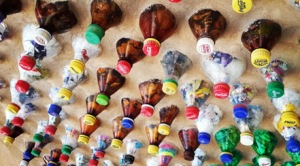
image courtesy of EcoBrick Exchange
One of my primary aims in making better environmental choices is to reduce my plastic consumption. After watching Chris Jordan’s heartrending film Albatross: https://www.albatrossthefilm.com/watch-albatross, I felt I couldn’t stand by any longer and be part of the problem.
Since watching the film I’ve taken a long hard look at how much plastic I’m using, found alternatives and switched over. If I’ve learnt anything, it’s a process and quite a long one. I’m not a pro at it by any means and I know I could still be doing better. However, in the interests of practising self kindness, the important thing is that I’ve made changes and I’m not going to stop making changes. One step at a time, right?
A worrying problem I came up against early on was non-biodegradable plastic. Things like: food films, sweet wrappers and bread bags. etc. Although some supermarkets will take soft plastics to be recycled, this does require energy (as does all recycling) and plastics can only be recycled once or twice. I reduced as much as I could but we all know there’s going to be that occasion when you’re having a ridiculous week and you can’t fit in making bread like you’ve promised yourself you will. So you buy bread in a bag. Or those occasions when you try and buy locally sourced, sustainable fish from the fish van around the corner where you can use your own containers only to be told, ‘they don’t come out in the winter time’ (true story…). So you have to get sustainable fish from the supermarket covered in a non-biodegradable film and sitting in a grey/black plastic tray. I found myself in despair over these items. After an internet search that involved lots of frustrated looking question marks at the end of ‘what can I do with my non-biodegradable plastic’, I came across the concept of ecobricking.
What, you may ask, is an ecobrick?
Simply put, as per the description from https://www.ecobricks.org, an ecobrick is ‘a reusable building block created by packing clean and dry used plastic into a plastic bottle to a set density.’
I watched this handy video (see below) which told me more about the ecobrick vision. If like me you’re interested in managing your non-biodegradable plastic, I would encourage you to watch it too:
https://www.ecobricks.org/what/
As they point out on the site, ‘Ecobricks enable us to take personal responsibility for our plastic.’ In my mind it’s a twofold thing. By ecobricking, you remain aware of every bit of plastic you use and as you watch in horror as it builds up in your clean plastics box, despite your best efforts not to buy things with non-biodegradable plastic involved, you vow more than ever to knuckle down and find alternatives.
The process is simple:
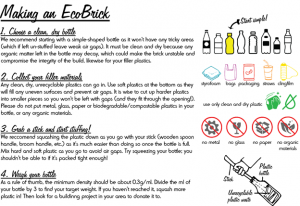
Once made, you can then either use your bricks for your own projects or register and drop them off at a designated collection point for use in community building projects.
My own journey with ecobricking has been, so far, as successful one. Apart from a few minor problems such as sticking my ‘pokey stick’ through the plastic bottle/having to start again, my kitchen looking like a plastics factory as everything dries and my hands aching from cutting up plastic…we’re all good. I would recommend joining the facebook group Ecobricks UK or following groups like EcoBrick Exchange to share your progress, ask questions or access useful resources. It feels nice to know that if I need to, there’s a whole community waiting to support me.
While I’m navigating the world of plastic free alternatives whilst trying to keep to a budget (I’ll discuss this in another post), ecobricking is like a soothing salve to my conscience. I know we have concerns that it’s not ridding the world of plastic. However, it does provide a solid middle ground for us everyday folks who are conscious of changing our ways but need a helping hand with finding safe and eco-friendly options for doing something about non-biodegradable plastic if we don’t manage to avoid using/buying it.
I’ll leave you now with some top ecobricking tips and pictures of the different stages from my own ecobricking attempts and wish you lots of luck with your own ecobricking journeys:
Top Ecobricking tips:
- Make sure you thoroughly wash and dry all plastic otherwise it can go mouldy inside the bottle.
- Use a symmetrical bottle (ie: no milk bottles with handles) and make sure that its see-through for ease of verification.
- Get a good pokey stick: ie: the end of a wooden spoon or a sharpening steel.
- Cut plastic into really small pieces to ensure you can stuff as much in as possible.
- Layer hard and soft plastic. Start with soft plastic to get into the crevices at the bottom of the bottle.
- Once cut plastic is inside the bottle, roll it under your foot and put it on a radiator. This helps the plastic to soften which means it can be compressed much more.
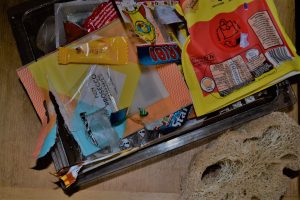
Plastics to wash with my eco-friendly loofah sponge!
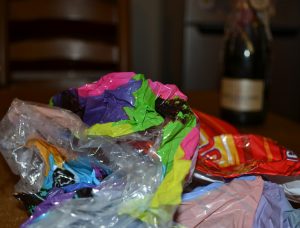
Clean and dry…waiting to be chopped
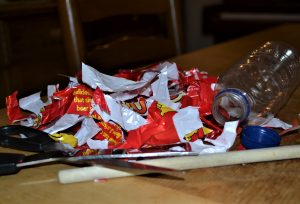
Cutting and stuffing…pokey stick at the ready
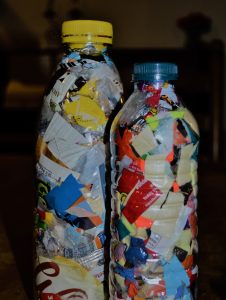
Some time later…ecobricks ARE GO!

L x
2 Comments
Edwardo Sweeten
Thank you for your blog article.Really looking forward to read more. Will read on…
Lottie
Thank you Edwardo – so glad you enjoyed reading my first eco journey post. Hope you enjoy the one I’ve just posted – do let me know!